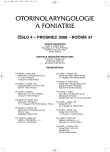Surgical Therapy of Primary Tumors of Orbit
Authors:
I. Šlapák
Authors‘ workplace:
Klinika dětské otorinolaryngologie LF Masarykovy univerzity a FN, Brno
přednosta prof. MUDr. I. Šlapák, CSc.
Published in:
Otorinolaryngol Foniatr, 57, 2008, No. 4, pp. 206-209.
Category:
Original Article
Overview
Orbital tumors belong to less frequent diseases of the head region. Orbital tumors may be divided in primary and secondary ones. The leading symptom is the bulb protrusion, diplopia and vision disorders. Medial and lateral orbitotomy are the most frequently used approaches.
Material and Methods:
in order to evaluate diagnostic and therapeutic methods and their results the authors performed a retrospective analysis of the groups of patients who were operated on in the period of 1972 – 2007 for primary orbital tumors at the ORL Clinic, LF MU FNUSA a KDORL LF MU a FN Brno.
Results:
In the given period of 36 years (1972-2007) a total of 48 patients at the age of one to 89 years were operated on. In three other patients, decompression of orbit for endocrine orbitopathy was performed. Among these patients were 11 men (mean age 50 years) and 37 women (mean age 52 years). Decompression was performed one on the right and on the left and once bilaterally. Medial orbitotomy was performed in 16 cases, lateral orbitotomy in 22 cases. In 9 cases, frontal orbitotomy was made, in one case the tumor was removed by trans-conjunctival approach. In three patients, endonasal endoscopic orbital decompression was made. Types of tumors: hemangioma 16 times (10 times capillary, 6 times cavernous), pseudotumor 8 times, neurofibroma 3 times, adenoma 3 times, histiocytoma 3 times, hemangiopericytoma 2 times, neurinoma twice, lymphoma twice, lymphoepithelioma, osteosarcoma, hamartoma, carcinoma, metastasis of kidney sarcoma, spongioblastoma, meningeoma, A-V malformation and cyst were diagnosed once each.
Complications:
Less serious ones (hematoma and lasting edemas of eyelids) occurred in 8 cases. A post-operation unilateral blindness was a severe complication in a 26 –year man with orbital metastasis of kidney sarcoma.
Conclusion:
Diagnostics and therapy of orbital tumors must be dealt with by a collaborating team of specialists of different medical branches: otolaryngologist, ophtalmologist, radiodiagnostic specialist and a pathologist. It is necessary to concentrate the patients with orbital tumors into specialized centers.
Key words:
primary orbital tumors, diplopia, CT, MNR, medial orbitotomy, lateral orbitotomy.
Sources
1. Demirci, H., Shields, C. L., Shields, J. A., Honavar, S. G., Mercado, G. J., Tovilla, J. C.: Orbital tumors in the older adult population. Ophthalmology, 109, 2002, 2, s. 243-248.
2. Gdal-On, M., Gelfand, Y. A.: Surgical outcome of transconjunctival cryosurgical extraction of orbital cavernous hemangioma. Ophthalmic. Surg. Lasers, 29, 1998, 12, s. 969-973.
3. Gierek, T., Pilch, J., Majzel, K., Markowski, J:. The assessment of lateral orbitotomy by Kronlein-Reese-Berke in surgical treatment of primary non-malignant orbital tumors. Klin. Oczna, 101, 1999, 2, s. 115-118.
4. Jianhua, Y., Zhongyao, W. Yongping, L.: The differentiation of idiopathic inflammatory pseudotumor from lymphoid tumors of orbit. Analysis of 319 cases. Orbit, 23, 2004, 4, s. 245 -254.
5. Johansen, S., Heegaard, S., BŅgeskov, L., Prause, J. U.: Orbital space-occupying lesions in Denmark 1974-1997. Acta Ophthalmol. Scand., 78, 2000, 5, s. 547.
6. Kang, J. K., Lee, I. W., Jeun, S. S., Choi, Y. K., Jung, C. K., Yang, J. H., Kim, D. S.: Tumors of the orbit. Pitfalls of the surgical approach in 37 children with orbital tumor. Childs Nerv. Syst,. 13, 1997, 10, s. 536-541.
7. Khan, A. M., Varvares, M. A.: Traditional approaches to the orbit. Otolaryngol Clin. North. Am., 39, 2006, 5, s. 895-909.
8. Maroon, J. C., Kennerdell, J. S.: Surgical approaches to the orbit. Indications and techniques. J. Neurosurg., 60, 1984, 6 s. 1226-1235.
9. Otradovec, J.: Volba chirurgického přístupu k orbitálním expanzím. Čes. Oftalmol., 39, 1983, 3, s. 194-197.
10. Otradovec, J.: Ornitologie. Čes. Oftalmol., 39, 1983, 2, s. 94-99.
11. Ohtsuka, K., Hashimoto, M., Suzuki, Y.: A review of 244 orbital tumors in Japanese patients during a 21-year period: origins and locations. Jpn. J. Ophthalmol., 49, 2005, 1, s. 49-55.
12. Ramsey, D. T., Fox, D. B.: Surgery of the orbit. Vet. Clin. North Am. Small Anim. Pract., 27, 1997, 5, s. 1215-1264.
13. Rodahl, E., Bertelsen, T., Seland, J., Arnes, J. B., Mork, S.: Orbital tumors. Tidsskr Nor. Laegeforen, 120, 2000, 29, s. 3518-3523.
14. Rubin, P. A., Remulla, H. D.: Surgical methods and approaches in the treatment of orbital disease. Neuroimaging Clin. N. Am.: 6, 1996, 1, s. 239-255.
15. Shields, J. A., Shields, C. L., Scartozzi, R.: Survey of 1264 patients with orbital tumors and simulating lesions: The 2002 Montgomery Lecture, part 1. Ophthalmology, 111, 2004, 5, s. 997-1008.
17. Šlapák, I., Přívara, M.: Expanzní procesy paranasálních dutin sekundárně postihující orbitu. Čsl. Otolaryngol., 34, 1985, 6, s. 342-345.
18. Šlapák, I., Wittbrodt, S.: Primární tumory orbity. Čsl. Otolaryngol., 37, 1988, 5, s. 298-303.
19. Šlapák, I., Šlapáková, O.: Surgical approach to orbital tumors. Revista Brasileira de Cirurgia de Cabeca e Pescoco, 29, 2002, 4, ISSN 0100-2171.
20. Šlapák, I., Vlková, E.: Tumory orbity - diagnostika a chirurgická terapie. Brno, Masarykova univerzita, 1993, 45 s.
Labels
Audiology Paediatric ENT ENT (Otorhinolaryngology)Article was published in
Otorhinolaryngology and Phoniatrics

2008 Issue 4
Most read in this issue
- Vestibular Schwannoma
- Pemphigus Vulgaris
- Relation of PTA and SRT (Pure Tone Average - Speech Recognition Threshold)
- Primary Squamous-Epithelial Carcinoma
